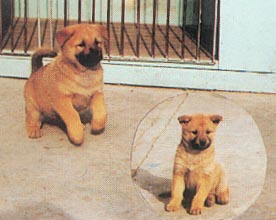The Context
When it comes down to a discussion of coat colors in Jindos, it's important to keep in mind two questions.
1. What colors are possible in the Jindo vs. impossible in the Jindo?
2. What is desired in the Jindo (by Koreans) vs. what is not desired in the Jindo?
In order to answer the first question, it's necessary to become familiar with the coat colors historically found in Jindos. With this knowledge, a chart of possible genes combinations and possible phenotypes can be predicted.
In order to answer the second question, it's necessary to have free flowing conversations with Korean old-timers who are knowledgeable about Jindos and about what is desired in Jindos. Earnestness to learn has to be proven in order to go beyond the superficial polite talk that is caused by a wariness to offend.
Overview
The coat colors that were historically protected by the Japanese government during the occupation and then Korean government were yellow and white. However, the selection of only just these two colors was inaccurate. Other coat colors existed in Jindos and these colors were barely preserved until the protection law was revised in 2/23/98, protecting other colors.
There are five colors that seem to be universally accepted in the Korean Jindo dog now.
1) Hwanggu : yellow,
2) Baekgu : white,
3) Naenunbakyi or Heukgal : black & tan,
4) Jaegu : grey,
5) Hogu or Hopi : tiger-brindle.
A handful of Korean organizations and now the FCI standard have included another color:
6) Heukgu : solid black
Based on these colors, the following table lists the probable alleles in the Jindo.
| Loci |
Relevant Alleles |
| A |
Agouti yellow = Ay
Agouti grey = A or Ag
black/tan = at
recessive solid black = a |
| E |
Full color = E
recessive yellow/white = e |
| K |
Brindle = Kbr
normal pattern = k |
| C (theorized) |
Full color = C
chinchilla dilute = cch |
Controversial colors will be covered in the next websection.
Ghosting
"Ghosting" is an English term describing how the ventral (bottom) portion of the dog is white or cream in color in an animal. This ghosting is not obvious in a young puppy coat but develops with age. The skin underneath the coat may be black, but the fur is white or cream.
This ghosting is famed in the Japanese breeds and is called "urajiro" by the Japanese. Not all Jindo dogs will show this ghosting clearly. This isn't as big of a concern in the Korean Jindo as it is in the Japanese breeds. However, too much white on a yellow dog might indicate some Japanese Akita Inu influence and the dog should be examined carefully for the presence of other Akita features.
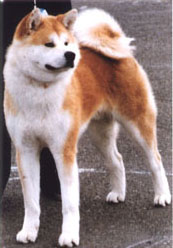
Japanese-style Akita |
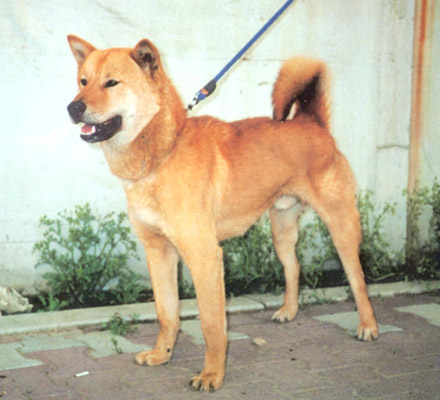
Korean Jindo |
Yellow Jindo dogs with distinct "urajiro", especially showing white dots above the eyes, are sometimes called "e baek yi", which refers to "two -eyes." These dogs are in the minority, and in show competitions, they are not as favored.
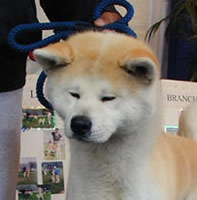
Japanese-style Akita
photo by Ann Kim |
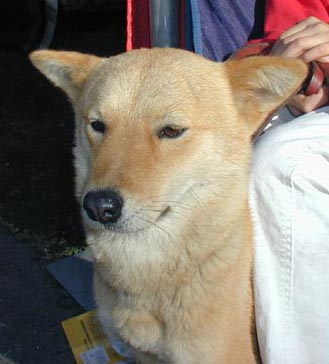
Typical Korean Jindo
photo by Ann Kim |
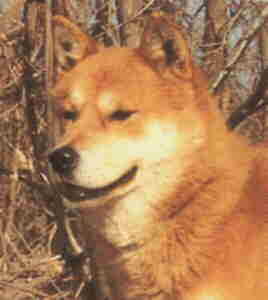
"E Baek Yi"
photo by Woo, Mu Jong |
It is unknown how ghosting is inherited. At one time, it was speculated in Shibas that cream genes created or enhanced urajiro, but this has been debunked as coincidence.
Masking
Yellow puppies are born dark brown with a very dark or black face. The color lightens and the mask on the face usually disappears as the puppy matures.
However, there are a few adult Jindos who retain black on the edge of their muzzles or a slightly smutty face (not as dark as an American Akita though). Some people believe this to be indicative of mix breeding (shepherd, akita, etc.) , while others believe it is a throwback to the Jindo's ancestors from Mongolia.
--------------------------------------------------------------------------------------------------------------------------------
The Colors
1. Korean Name = Hwanggu
common English names = yellow, wheaten red, red on white bicolor, orange, fawn, tan
gene = Agouti yellow (Ay)
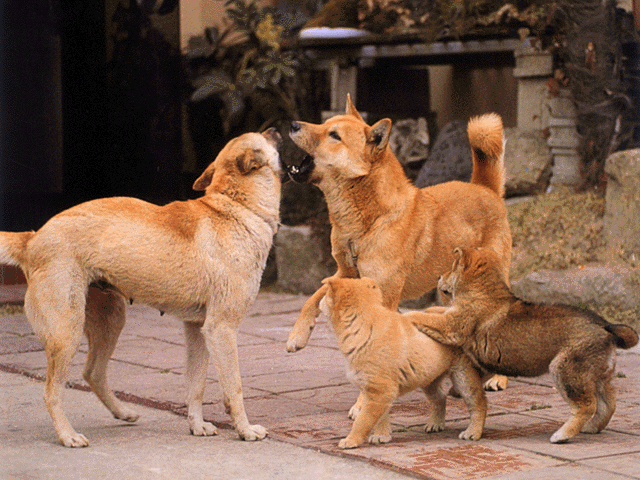
Photo by Im, In Hak |
Literally in Korean, hwang means yellow. Hwang has often been equated with "red", a term that is based on dog lingo carried over from describing other breeds such as Shibas and Akitas.
Hwanggu is the most prevalent color among Jindos. The Agouti yellow gene (Ay) which causes this color is a dominant gene that is found in Australian dingos and many other Asian dogs.
Pups are born dark brown with a black mask. As they mature, the brown color recedes to a yellowish color and the mask fades away.
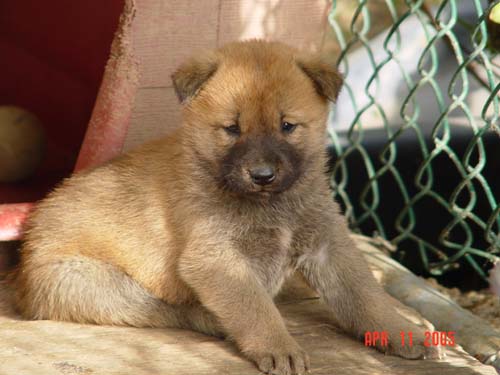
This young pup has already started to lighten on the head and on the back.
photo by Johnathan Lee |
The term Hwanggu has been used to encompass dogs possessing a wide variety of shades. The fur color ranges from red to orange-yellow to fawn/tan. This variation is dependent on the genetic composition of the dog and whether there is complete dominance or incomplete penetrance of the genes involved. For example, dogs that have cream in their background may end up lighter in color than those with no cream. Those carrying black/tan genes may end up more brown/tan.
The whiskers are black, and close examination of the coat will usually reveal either a black band in the individual guard hair or black hairs behind the ears. There should be no dilution of this black hair to chocolate/liver or blue.
The preferred color for Hwanggu is the same yellow color as a field of barley.
Good Color for a Hwanggu |
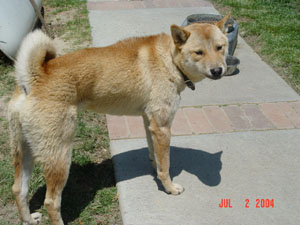
photo by Johnathan Lee |
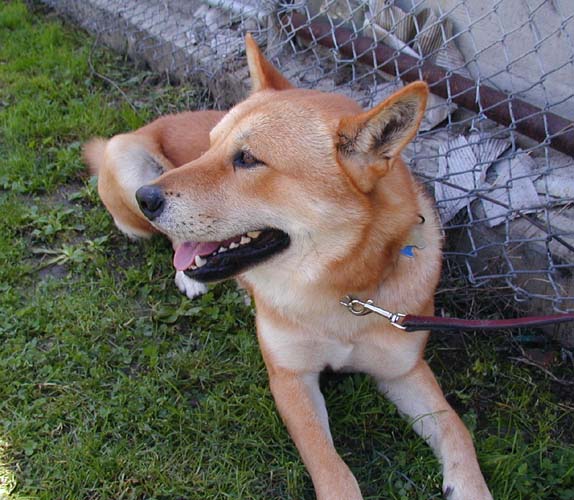
Photo by Ann Kim |
Probably too red/brown
(Lighting can affect perceived color) |
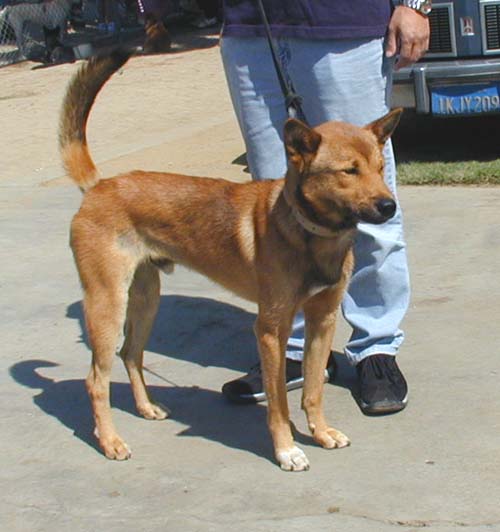
Photo by Ann Kim |
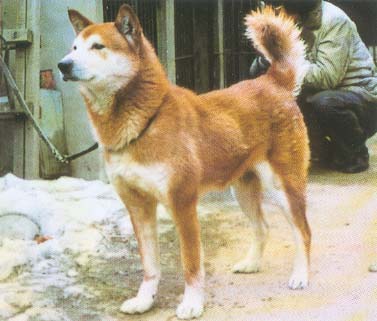
Dog also has a reverse mask which isn't favored
Original photo source unknown |
| Probably too pale |
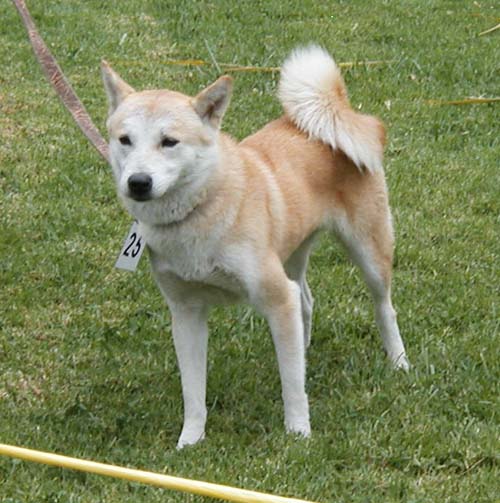
Photo by Ann Kim |
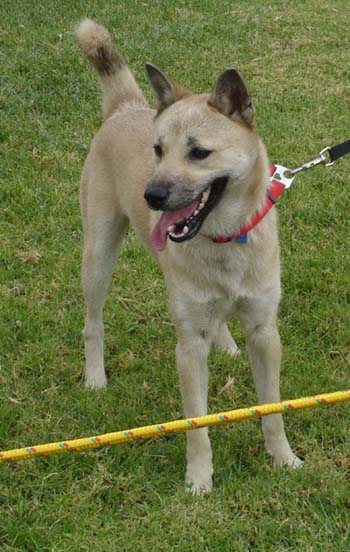
Photo by Ann Kim |
Some Hwanggu may have a scattering of black hairs or darker hairs on the back that are visible from a few steps away. (Note that this is not a saddle as seen in beagles.) In top level competitions where there are dogs very close in quality, such a black-haired Hwanggu may lose out to a clean Hwangcu.
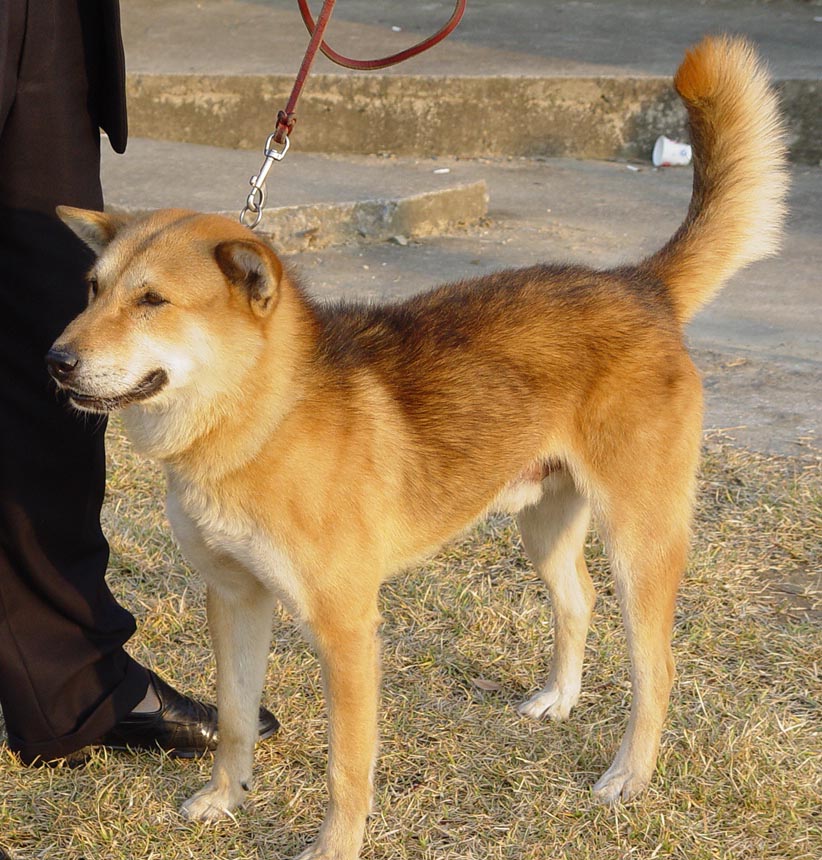
A very nice black-haired Hwanggu
photo by Johnathan Lee |
There is an alternative color called Jaegu (grey), but a dog would need much more black hairs. A criteria of "enough black" for a Jaegu is for the fur to have a bluish sheen in full sun.
2. Korean Name = Baekgu
common English names = white, cream
gene = recessive yellow (e) and/or theoretical chinchilla-dilute (cch)
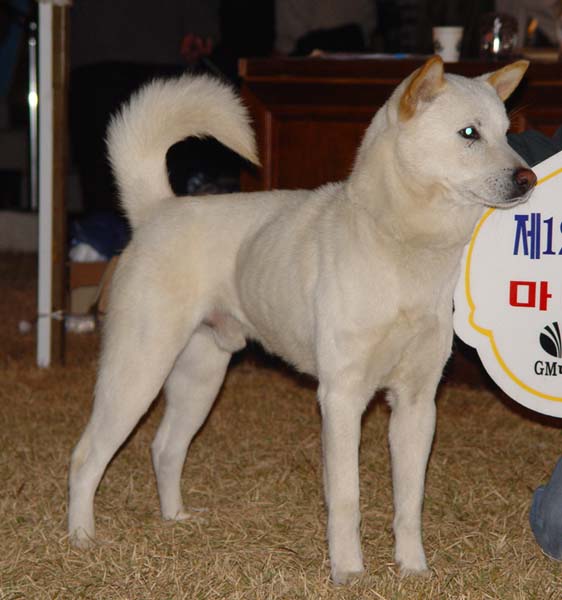
2003 Jindo Island champion (mainland)
photo by Johnathan Lee |
Baek is one of two Korean words for the color white (HieYang being the other). In Korean, it is more appropriate to describe certain objects with one descriptor over the other.
Baekgu is the second most common coat color among Jindos. It would be highly inaccurate to described the color as a rare color even though it is caused by one or more kinds of recessive genes. These genes are recessive to full pigmentataion.
Current research literature supports that cream/white color in dogs is linked to the recessive yellow gene (e). This gene removes pigment from hairs to produce either a yellow dog, as seen in golden retrievers and yellow labradors, or a white dog, as seen in white German Shepherds and white poodles.
The theorized chinchilla-dilute gene (cch) is believed to primarily remove red pigment from hairs (and to a lesser extent black pigment) to produce a white dog as seen in Japanese Akitas, Siberian huskies, and Alaskan Malamutes. Combined with the recessive yellow gene, it's believed that this gene can lighten yellow fur color to white.
Baekgu Jindos and nearly all dog breeds do not have pink eyes, brillant white coat, and all pink leather that is associated with albino rodents and rabbits. If ever a pink-eyed albino Jindo is produced, they should not be breed at all since these dogs are sensitive to light and would spread this genetic disease to the general Jindo population.
White dogs with blue eyes are considered mixes or may have a form of albinoism called tyrosine-negative albinoism. These should also not be bred as examples of tyrosine-negative albinoism in other breeds and animals are linked to genetic diseases as well.
When Baekgu pups are born, they are white with pink skin pigment. As weeks pass, they grow into a creamy fur color and black pigment fills in the skin leather, particularly on the eyelines, lips, and nose. By 4 weeks of age, they should have solid black noses which may either stay solid or fade in the center to flesh/pink-colored as they grow into adulthood.
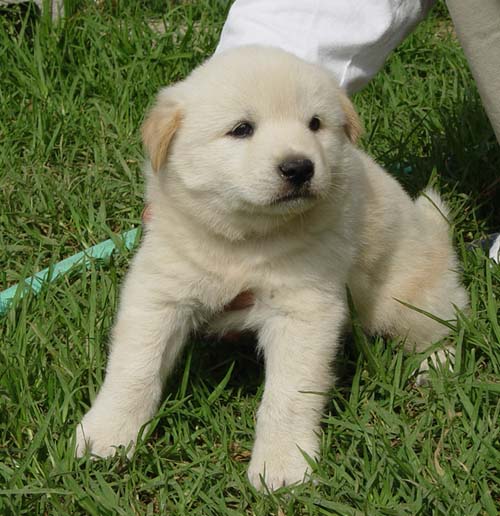
A Baekgu pup
Photo by Johnathan Lee |
Adult Baekgus usually end up being a soft white color rather than a brillant snow white color. Snow white is regarded as a Japanese Kishu color by some organizations.
One Jindo judge has referred to the Baekgu color as a Chosun (Joseon) white as found in Korean porcelein.
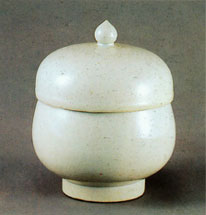
Joseon porcelein from the 15th century
Photo source: Gwangju National Museum |
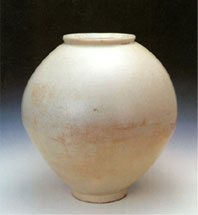
Joseon porcelein from the 17th century
Photo source: Gwangju National Museum |
The typical Baekgu has a white body with red highlights on the ears and the back of the hindlegs. Whiskers on Baekgus are white. It is not desired that the body be reddish in color.
The red color on the ears and back of the hind legs is not as preferred by Jindo islanders (source: Mr. Tae Young Yim).
Probably too Muddy
(lighting can affect perceived color) |
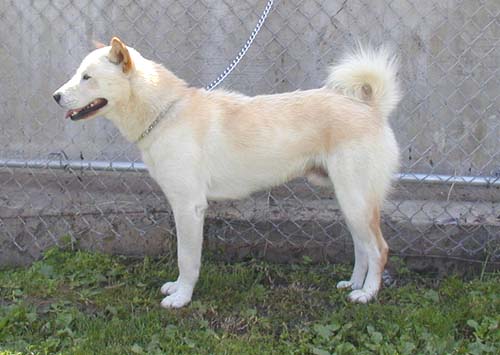
Body has reddish tinge.
Photo by Ann Kim |
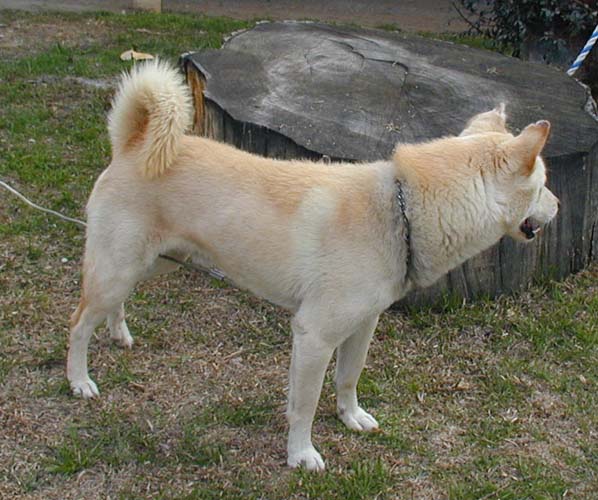
Body has reddish tinge.
Photo by Ann Kim |
| Typical Baekgu |
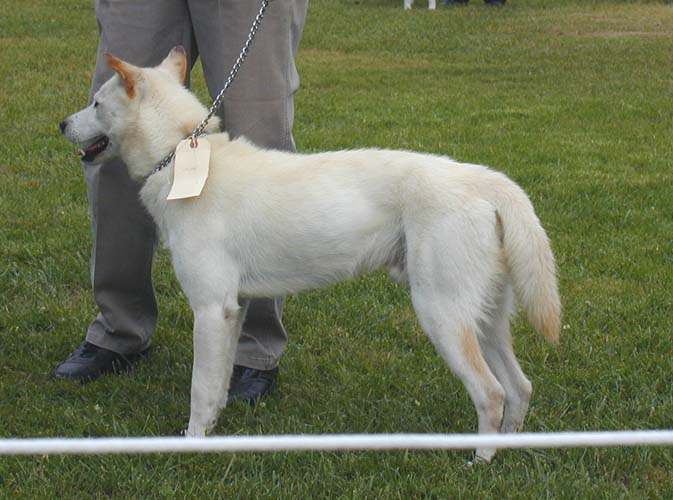
Body is white.
Red highlights are found on ears, tail, and back of legs.
Photo by Ann Kim |
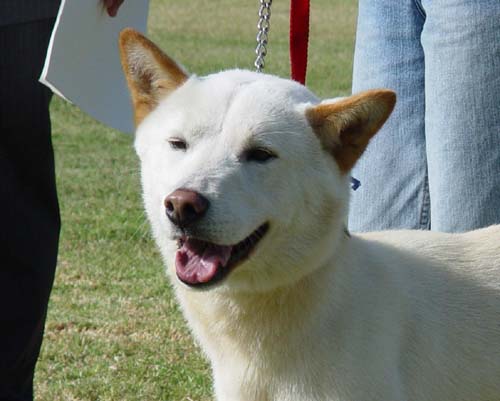
Red-tipped ears.
Photo by Johnathan Lee |
| White desired by Jindo Islanders |
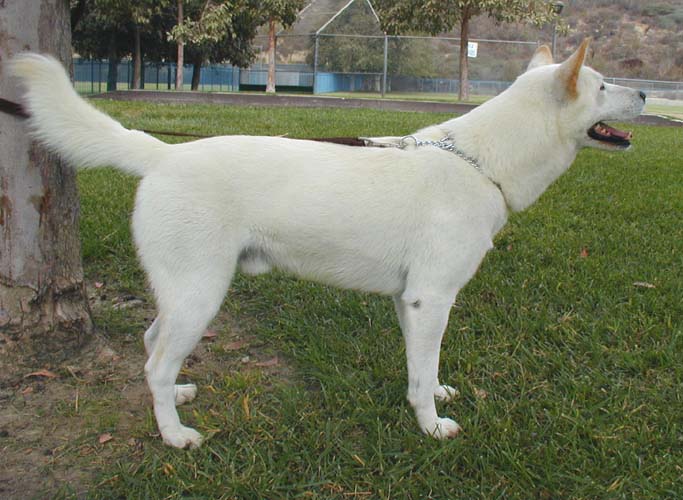
Body is white.
Red highlights are missing on legs.
Photo by Ann Kim |
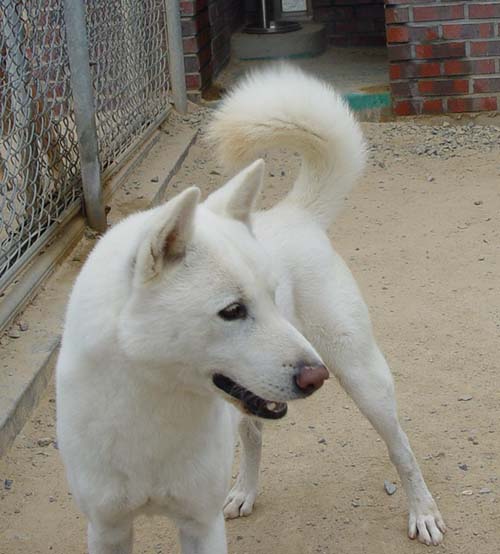
Unusual, all-white ears
Photo by Johnathan Lee |
In stories, there are supposed to exist Baekgus with black hairs on the back. This is considered a very good coat, but without any pictures, it is unclear if this is a misnomer. Perhaps it could be a Hwanggu or a Jaegu with a very light coat color.
3. Korean Name = Naenunbakyi or Heukgal
common English names = black and tan
gene = black/tan (at)
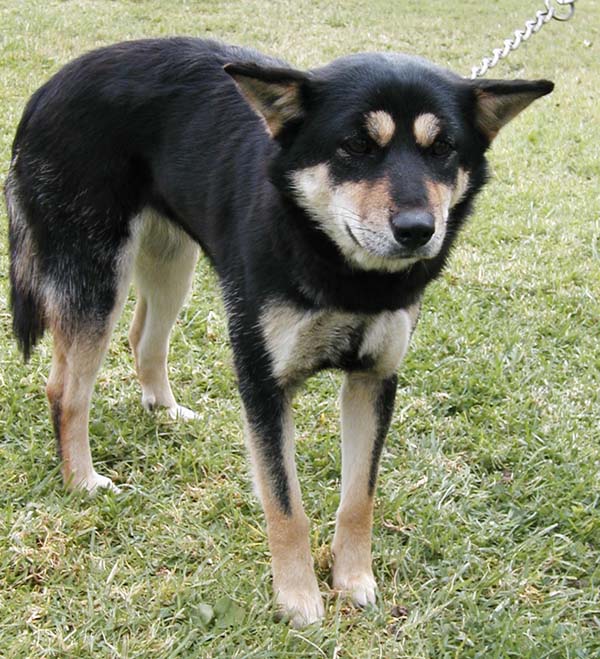
Photo by Ann Kim |
The term Naenunbakyi literally means four eyes, in reference to the two spots on the brow and to the two eyes.
The number of black/tan Jindos was alarmingly low two decades ago due to the Korean government historically recognizing only yellow and white Jindos. However, their popularity has skyrocketed in recent times, mostly due to the efforts of Mr. Woo, Mu Jong of the KNDA promoting the benefits of black skin pigment in dogs. There are breeders that specialize in the color, and now black/tans are the third most common color among Jindos.
The black/tan gene (at) that causes the color is located on the same loci as the Agouti yellow gene (Ay). Black/tan is recessive to Agouti yellow.
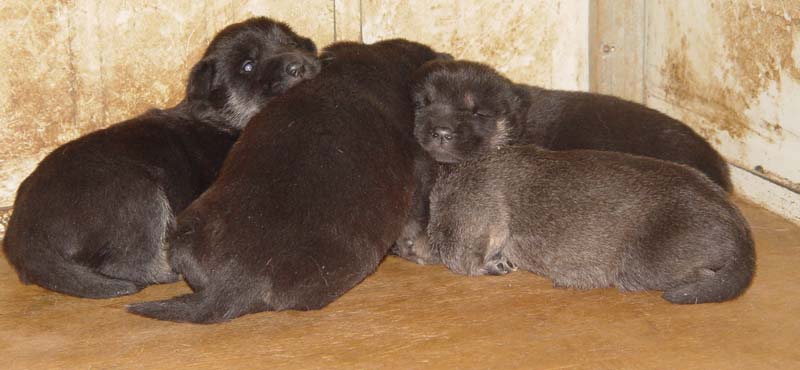
A pile of three black/tan pups and one yellow or grey pup.
Photo by Johnathan Lee |
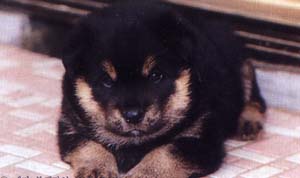
An older pup
Photo by Woo, Mu Jong |
The black & tan markings on the dog should be clearly defined. The tan portion varies in intensity, from nearly white to faded tan to solid tan. This is probably dependent on whether the dog has the theorized chinchilla-dilute genes that only affect red hairs.
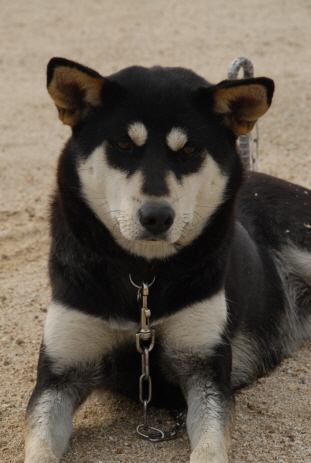
This "black & white" color is hardly ever seen.
Photo posted by "chungdam" on www.jindomania.com. |
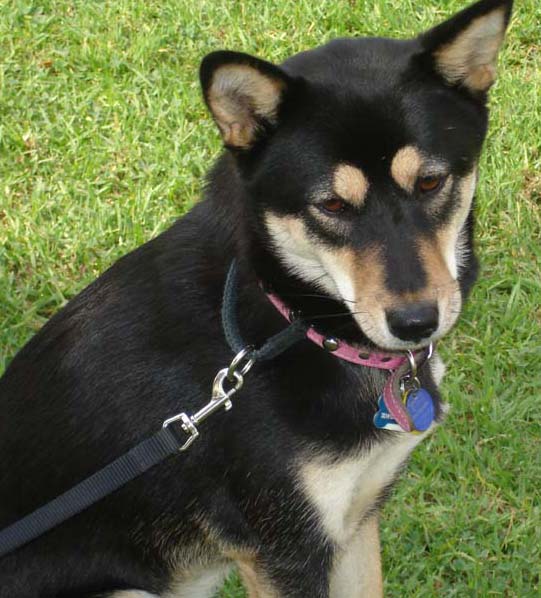
Favored for the black, tan, and white fur colors.
Photo by Ann Kim
|
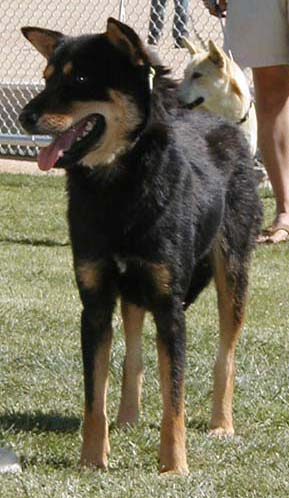
Favored as it is linked to black skin pigment and improves black skin in offsprings.
Photo by Ann Kim |
The black coat can be red-black due to several factors, such as bleaching in the sun, a red-black middle band in the individual guard hair, or a red undercoat. If the dog carries black masking, brindle, or solid black, the distribution of the black will be greater.
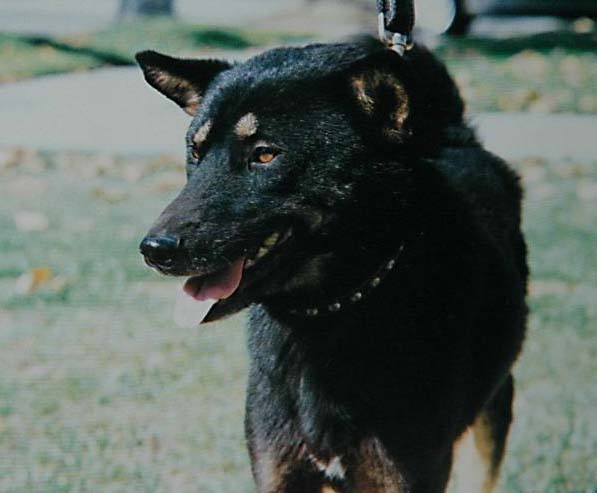
"Tyson", a black/tan stud imported to the US.
Could be carrying recessive solid black?
Photo dated 1995. Source unknown. |
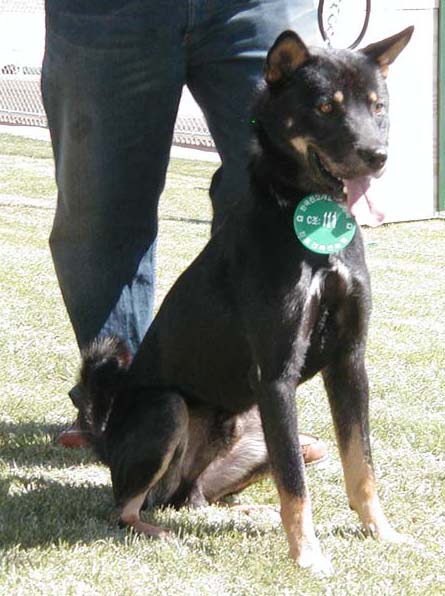
A great-grandson of "Tyson". Black covers a greater portion of the face, creating cheek spots and smaller eye spots. The black also travels down the inside of the upper legs.
Photo by Ann Kim |
4. Korean Name = Jaegu
common English names = grey, wolf-grey, ash, sesame, sable
gene = Agouti yellow + black/tan (Ay at) or Agouti grey (A)
The word "Jae" means ashes and is commonly used to describe the grey color found in wolves.
Jaegu appears to be the most complicated color in the Jindo breed. There are several genes and gene combinations that give rise to the dogs that are referred to as Jaegu. These, in turn, are affected by unknown genes that modify the intensity of the color.
The one trait that ties all the variations together is the appearance of red, black, and white hairs.
a. Sable varient
The most common Jaegu is one that is due to one copy of the Agouti yellow gene combined with one copy of the black/tan gene (Ay at). This phenotype is sometimes called sable. This is the most common because the distribution of the black/tan gene (at) has skytrocketed in the Jindo gene pool, and of course, there has always been yellow Jindos with Ay around.
Ideally, according to Jindo county residents, a Jaegu has darker fur that covers the upper portion of the body and head. Also, in the sun, the coat looks blue. It is incorrect to state any red Jindo with black fur is a Jaegu. It must have the bluish sheen in sun or else it is referred to as Hwanggu or black-haired Hwanggu. The dark pattern usually appears as a widow's peak on the forehead and does not to travel down the front of the legs.
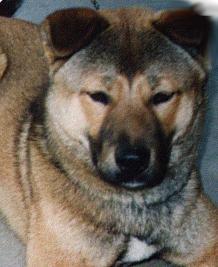
Photo by Ann Kim |
Here are some additional pictures of sable grey.
Jindo County Greys
Grey female from Mr. Kang's site
Grey female from Mr. Kang's site
Close-up of fur from Mr. Kang's site
Greys photographed by Mr. Yim, Yin Hak
a grey female
another picture of a grey female
It can be difficult and/or unpredictable to produce this grey. There is something else, a modifier, that varies the expression of this combination. It causes Ay to be completely dominant some times and incompletely dominant in other times.
Here are some examples of the modifier affecting the appearance of Ay at dogs.
Ay at phenotypes |
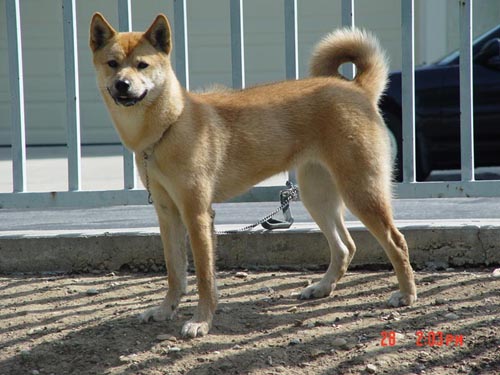
clean yellow color
photo by Bruce Kwon? |
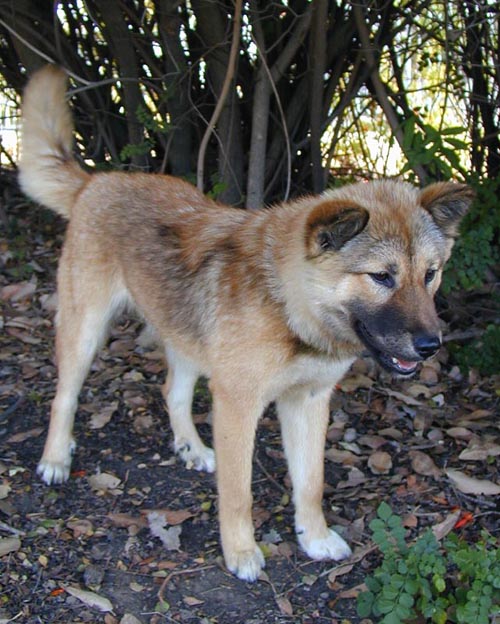
slight black tipping
photo by Ann Kim |
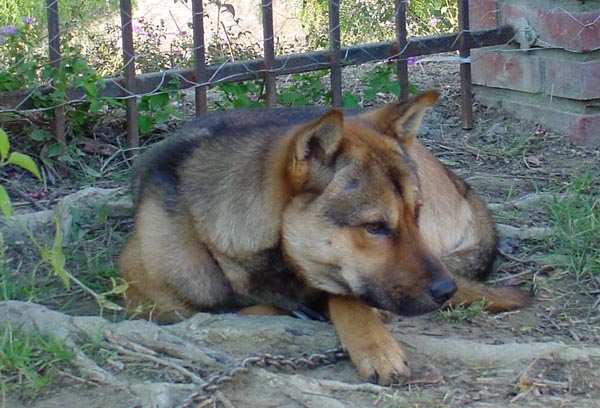
pronounced black
photo by Johnathan Lee
|
b. Agouti grey (Wolf grey) varient
The Agouti grey version of Jaegu (A or Ag) is still uncommon, and its appearance is easily altered by the presence of other color genes. Agouti grey differs from the sable grey in that the dark pattern is overlayed in the same general areas as a black/tan pattern. The dark mask is a full mask extending to beneath the eyes. The dark pattern extends down the front legs. The only minor difference is that there is almost always a ring of lighter color around the eyes whereas a black/tan may or may not have eyerings.
Agouti grey is completely recessive to Agouti yellow. It has a variable relationship to black/tan and solid black. In some cases it acts like full dominant, and in many cases heterozygotes are exactly halfway between the two patterns or even closer to the "recessive" one.
As seen in black/tans, the tan portion can vary from very faint to all tan.
Probably
A A |
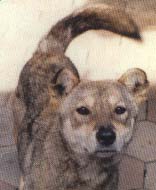
Photo by Woo, Mu Jong

Photo by Woo, Mu Jong
Photos by Lee, Sang Dae:
side head shot
front head shot
standing up
laying down
Unknown photographer
Head shot |
Probably
A at |
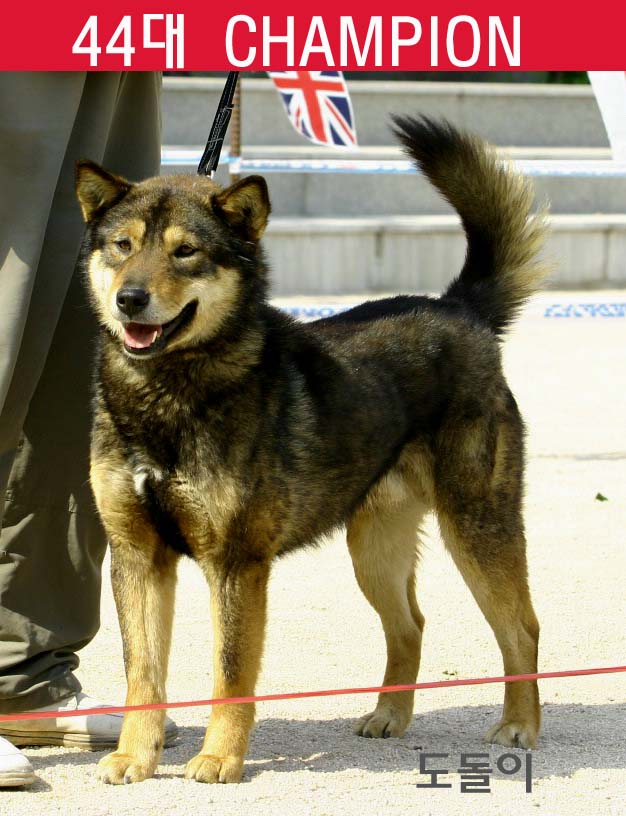
"DoDolYi"
44th Champion of the Korea Jindo Dog Association.
Photo source: KJDA website |
Probably
A a |
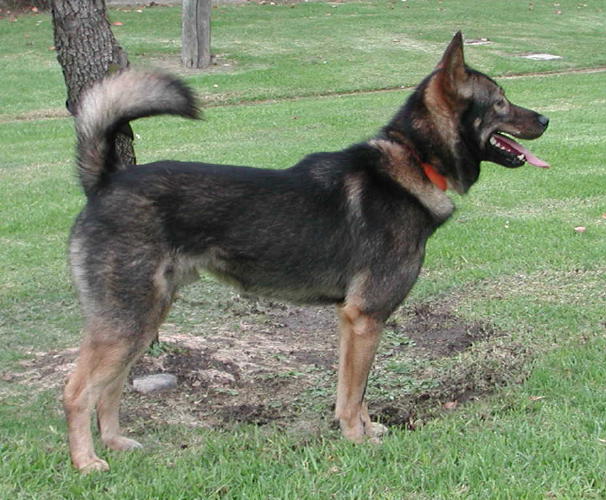
Photo by Linda Price
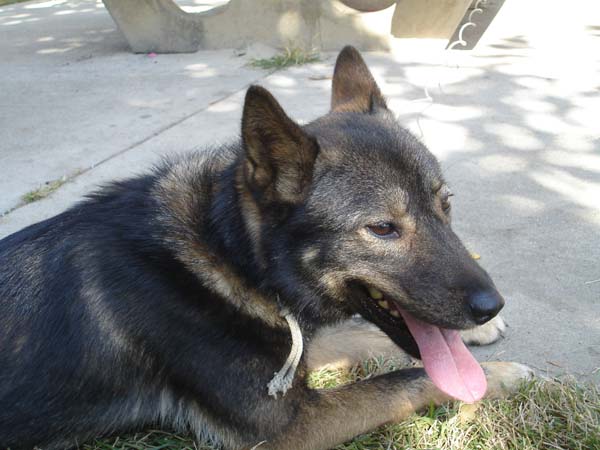
Photo by Ann Kim
Photo by Kim, Jong Dae:
Front view |
c. Non-grey Jaegu varient
According to the oldtimers on the island, there is another color called Jaegu or "wolf-color." It is a color that is not what Westerners would think of as wolf-color. It is also not a color that is really competitive in shows as it is considered somewhat of a deficiency.
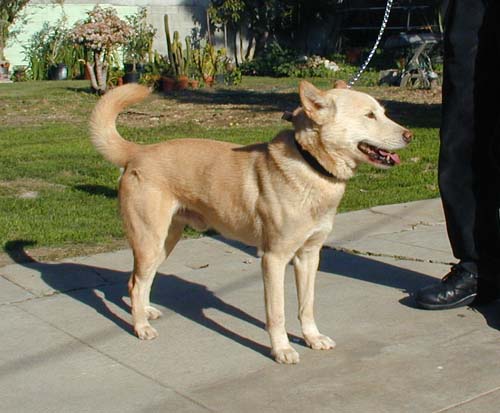 "Cheesecake", owned by Mr. Lim, Ik Ho "Cheesecake", owned by Mr. Lim, Ik Ho
Photo by Ann Kim |
This type of Jaegu appears as a normal Baekgu Jindo at birth, but instead of becoming lighter as the dog matures, the coat become darker and redder. It's believed that this dog would have grown the normal JaeGu grey color, but because it was lacking the desired black pigments, it turned this color instead. (source: Yoon, June Ho)
Alternatively, there are some pale yellow dogs with black whiskers and a scattering of black hairs on the back that are referred to as Jaegu by others.
5. Korean Name = Hogu, Hopi
common English names = brindle, red-brindle
gene = Brindle (Kbr)

Photo by Woo, Mu Jong |
The term "Ho" is associated with tiger. The 1988 Seoul Olympics had a tiger mascot named Hodori. The Korean name for tiger is Horangyi. The appeal of the Hogu color among some Koreans is due to this resemblance to the tiger.
Hogu can still be considered an uncommon color and is hardly ever represented at shows. Even though the color is caused by a dominant gene, Kbr, and should therefore have allowed a significant increase in numbers, their popularity has been hampered by the overwhelming presence of brindled mixes and poor quality specimens.
The thickness of the black lines, whether they lightly mark the dog or darkly mark the dog to make the dog nearly black, is genetic and appears to be due to some unknown modifer working with the Kbr gene.
Because this modifier is genetic in nature, this feature can be used somewhat to separate brindled Jindos from Japanese Kai mixes. It is not so sucessful in separating brindled Jindos from Akita mixes as the range of patterning in Akitas is much greater. In either case, a close examination of the eyes, head, and other physical traits would also need to be assessed to determine whether the dog is a Jindo or not.
The Hogu coat appears in the Jindo as a yellow/red background with thin, clearly defined black lines running vertically through the body. Careful inspection should show the white ghosting peaking through the brindle stripes. Puppies should show brindling at a young age.
In the Japanese Kai, there is some selection against the white ghosting or urajiro. The stripes are also more blurred and thicker. In some Kai, the dog appears solid black as a youngster and only show faint stripes after multiple sheds.
| Japanese Kai |
Korean Jindo |

"CH. Walnut Valley's Mavrik O' MM" owned by Classy Kennel
Photo by Marian Campbell |
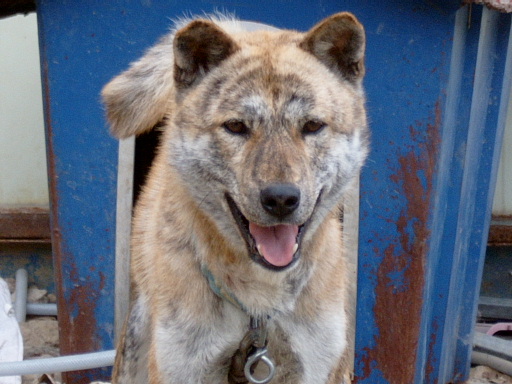
"HoJinYi"
photo posted by Woo Joo Sung on the KNDA board |
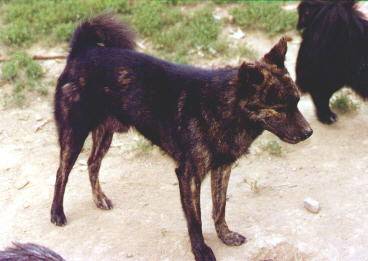
"Sony"
Photo by Colorado Shiba Rescue |
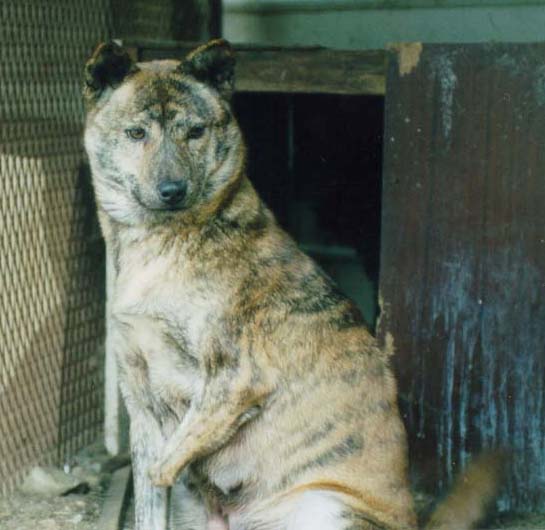
"PoHang"
|
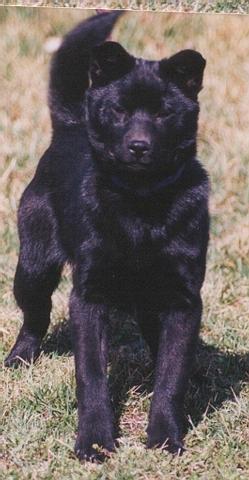
a young black-brindle female Kai, "Dolly"
Photo: Marian Campbell |
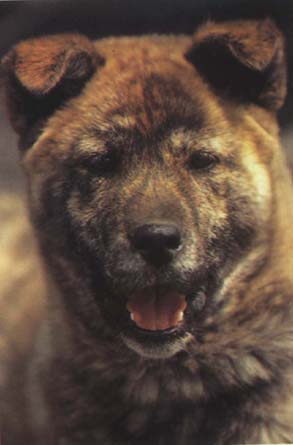
A young Jindo
from Jindok Gae by Yoon (p. 125) |
6. Korean Name = Heukgu
common English names = black, solid black
gene = recessive black (a)
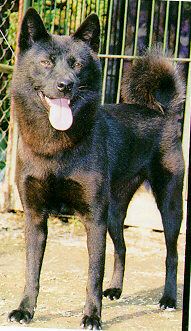
a black Jindo from the old Jindo Country site
original source unknown |
a solid black photographed by Mr Yim, Yin Hak
Black is an uncommon color for a Jindo, but it's not due to genetics. It seems to be the least favorite color among organizations as about half of the various Jindo organizations do not recognize it as a valid color. In general, the average Korean also does not like the color.
The general feeling within one organization is that long ago, solid black Jindos did exist, but now they are extremely hard to pick out from the Jindo-Chow mixes and the Japanese mixes.
An independent oldtimer was consulted, and his opinion was that there are certain characteristics of solid black Jindos that should be present and are lacking in the modern-day black dogs. The most notable characteristic is that black Jindos are not solid black. They should be edged with white under the armpits, behind the legs, and in the private areas. Due to the described placement, this is probably not white spotting but a white or lighter undercoat showing through.
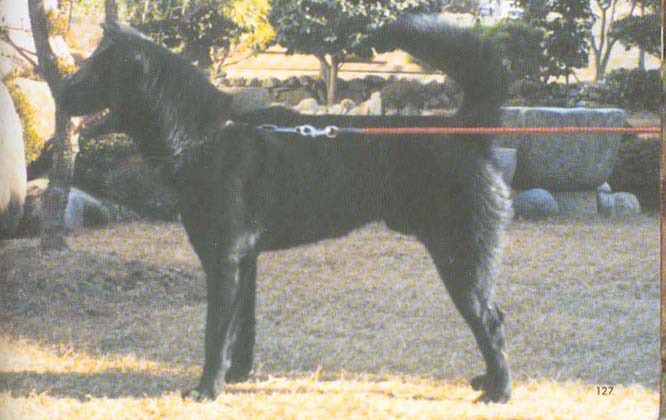
an example of a likely purebred black Jindo
Photo credit: KNDA & Woo, Mu Jong
|





